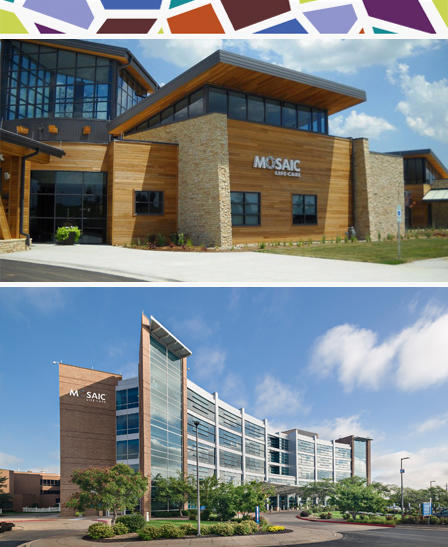Blogrige
The Official Baldrige Blog

Since its Baldrige Award win in 2009, Mosaic Life Care (formerly called Heartland Health) has continued to be nationally recognized for quality, value, and the patient experience. In 2015, Mosaic Life Care was named to the Truven Health AnalyticsTM 100 Top Hospitals® list, given an “A” rating by The Leapfrog Group, identified as a HealthStrongTM Hospital by IVantage® Health Analytics, and named a “Most Wired” hospital by Hospitals & Health Networks magazine. Based in St. Joseph, Missouri, Mosaic Life Care remains a nonprofit, community-based integrated health system serving the residents of northwest Missouri, northeast Kansas, southeast Nebraska, and southwest Iowa—the region's largest health system and employer. Since its Baldrige win, it has expanded its geographic reach into Kansas City north.
But it's the name that is a significant change for the health system, which is making a transition from providing health care to life care. In a virtual interview, I asked Martha Davis, Institute Leader at Mosaic, about the significance of the name change and how Mosaic is transforming health care. She gave me a sneak peek into her presentation for the upcoming Baldrige regional conference in Nashville about the importance of this transformation.
How would you describe the transformation from health care to life care? Why has this been important to your success?
We are an Accountable Care Organization and, as such, have recognized the need to move from a patient to consumer-centric approach. We’ve traditionally built service offerings around the acute and chronic health care needs of patients, but we haven’t always done a good job of engaging consumers to prevent or slow the effects of lifestyle, stress, aging, and other factors that impact one’s long-term health. Consumers are shouldering higher insurance plan deductibles and expect more cost transparency and better care experiences. We are also seeing great opportunities to partner with employers to help them lower cost through improved employee health support. Our life-care model is holistic and focused on health, wellness, and wellbeing.
What are your top tips (e.g., 3 to 5 suggested practices) for using Baldrige to support such a transformation?
We have built solid disciplines around planning and deployment of the Baldrige Excellence Framework, which has been invaluable as we’ve expanded into new geographic areas with very different competitive factors. Some of what we've learned follows:
- While our strategic priorities have remained the same, we’ve established reasonable but stretch measures given the startup of new offerings and services in our expanded geographic service areas. The linkage between measurement and results is critical during times of transformation and innovation—we have to be discerning about what services resonate with our consumers and which ones don’t, regardless of how great of an idea we think an offering is! Maintaining process focus is also essential to this work—not only to improve efficiency and lower cost, but also to improve the provider and consumer experience.
- In our customer focus, we are moving beyond patient satisfaction surveys to gain new insights into what our customers value. During the September session, we will talk about what we’ve learned about customer sacrifice by studying out-of-industry exemplars and adapting those learnings to our strategies. These new insights are helping us to develop life care offerings that engage and activate consumers in their own health and well-being.
- We’ve relied heavily on the People Framework we developed as a result of our workforce focus—especially in our new markets and expanded offerings. It is imperative that we hire and onboard the right people, provide the right learning and development opportunities, and provide the right feedback and recognition—whether it is with our leaders, providers, or workforce members. We constantly battle change fatigue and continually look at ways to positively engage our providers and workforce members.
What are a few key reasons that organizations in your sector can benefit from using the Baldrige Excellence Framework?
Two key reasons: first, there is enormous disruption in our industry—huge pressure to lower costs and improve the patient experience. With reduced reimbursement, organizations can’t waste precious resources on non-value-added work. The Baldrige framework is an excellent way to prepare for this disruption and upheaval. Second, a population health focus requires great change in the workforce composition: acute care services must leverage technology and tightly control labor costs; clinics need to do the same and be proactive at keeping patients healthy and out of higher-cost venues; and we need to offer scalable, virtual, and other forms of services to consumers who are mostly healthy. This requires that we rethink the skill sets we will need in the future and how we will attract, prepare, and retain the best workforce members. We like to think of the framework as a huge accelerating factor!
Join us at the 2015 Baldrige Regional Conferences to attend this session and many more from current and former Baldrige Award recipients.





